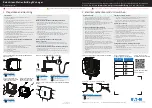
#
Pull lever
1
up as far as it will go.
The steering wheel is locked.
Stowage areas
Notes on loading guidelines
&
DANGER Risk of poisoning from exhaust
gases
Combustion engines emit poisonous exhaust
gases, such as carbon monoxide. Exhaust
gases can enter the vehicle interior if the
rear-end door is open when the engine is run‐
ning, especially if the vehicle is in motion.
#
Always switch off the engine before
opening the rear-end door.
#
Never drive with the rear-end door
open.
&
WARNING Risk of injury from unsecured
objects in the vehicle
When objects are unsecured or inadequately
secured, they can slip, tip over or be thrown
about, striking vehicle occupants.
This also applies to:
R
luggage or loads
R
seats which have been removed and are
being transported in the vehicle in an
exceptional case
There is a risk of injury, particularly in the
event of braking manoeuvres or abrupt
changes in direction.
#
Always stow objects in such a way that
they cannot be tossed about.
#
Before travelling, secure objects, lug‐
gage or load to prevent them slipping or
tipping over.
#
When a seat is removed, keep it prefera‐
bly outside the vehicle.
&
WARNING Risk of injury from inadequate
stowage of objects
If you do not adequately stow objects in the
vehicle interior, they could slip or be tossed
around and thereby strike vehicle occupants.
In addition, cup holders, open stowage
spaces and mobile phone brackets cannot
always restrain the objects they contain in the
event of an accident.
There is a risk of injury, particularly in the
event of sudden braking or a sudden change
in direction.
#
Always stow objects in such a way that
they cannot be tossed around in these
or similar situations.
#
Always make sure that objects do not
project from stowage spaces, luggage
nets or stowage nets.
#
Close all sealable stowage spaces
before you start your journey.
#
Stow and secure objects that are heavy,
hard, pointed, sharp-edged, fragile or
too large in the load compartment.
&
WARNING Risk of burning from the tail‐
pipe or tailpipe trim
The tailpipe and tailpipe trim can become
very hot. If you come into contact with these
car parts, you could burn yourself.
#
Always be particularly careful when in
the vicinity of the tailpipe and tailpipe
trims and supervise children very
closely when in this area.
#
Before any contact, allow the car parts
to cool down.
If you are using a roof rack, please note the maxi‐
mum roof load and the maximum load capacity of
the roof rack.
You will find information about the maximum roof
load in the "Technical data" chapter and informa‐
tion about roof racks in the "Carrier systems"
section .
Camera-based driving systems and the sensor
functions of the inside rearview mirror may be
impaired if you are transporting a load on the
roof and it protrudes more than 40 cm over the
edge of the roof. Therefore, make sure that the
load does not overhang by more than 40 cm.
The handling characteristics of your vehicle are
dependent on the load distribution. Therefore,
please observe the following notes when loading:
R
when transporting a load, never exceed the
permissible gross mass or the permissible
axle loads for the vehicle (including occu‐
pants).
R
the load must not protrude above the upper
edge of the seat backrests.
Seats and stowage
77
















































